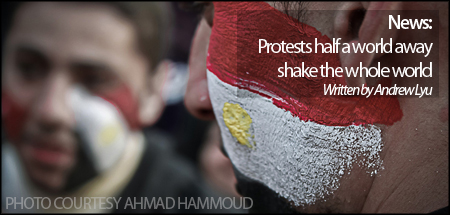
Starting in mid-December of 2010, a wave of protest and revolution has spread throughout the Islamic world in the Middle East and North Africa (MENA). Incidents have taken place in 18 countries, and in two countries, Tunisia and Egypt, heads of states have already been overthrown.
This wave of revolution started on Dec. 17, 2010 when the self immolation (setting oneself on fire as an act of martyrdom) of fruit merchant Mohamed Bouazizi sparked the Jasmine Revolution of Tunisia. Following protests, 28 days later on Jan. 14, President Zine El Abadine Ben Ali of Tunisia fled the country.
Eight days later, on Jan. 25, Egypt saw its large protest in Tahrir Square, Cairo, and this time the world took notice, now the most populous country in the MENA group had entered the fray. All eyes were set on Egypt. As one of the most influential countries in the region, Egypt set the tone for the current events in the MENA area.
In Egypt and throughout the Middle East, protesters called for changes. Politically, the people demanded freedom of speech and legitimate elections. In many MENA countries elections are corrupt. Often, the same President is in power for decades. In Egypt’s case, President Hosni Mubarak was in power for 30 years. Economically, the people called for more equal distribution of wealth. The poor and middle class suffer high unemployment, food price inflation, and low minimum wage.
One of the leading factors of unrest is the high percentage of youth unemployment. In many MENA countries, the youth comprise of a majority of the population. In Egypt, approximately 52.3 percent of the population is under the age of 25. By comparison, approximately 28.5 percent of the US population is under the age of 25.
Another striking characteristic of the revolution is the use of social media. The first protest in Egypt was organized by Google executive Wael Ghonim via a Facebook page. While press is heavily restricted by the state, dissenters have found power in less government controlled mediums such as Twitter and Facebook.
Media has struggled to shed light on the conflicts because foreign powers have been the target of hate; journalists have been attacked trying to report on the ground. The internet and television access are shut down in many countries during protests. Egypt for example, fell silent to the internet world on Jan. 27 when the state shut down all network connections.
On Feb. 11, after 18 days of protest, Mubarak officially resigned as President of Egypt. Currently the Supreme Council of Egyptian Armed Forces is in control of the government and the Egyptian constitution is being revised by an eight person committee of legal experts.
Now that the revolution is in its finishing stages in Egypt, people wonder how the outcome of reform will affect the world. On a small scale, the Muslim community has been shaken and impassioned by the event.
Even at Aragon, there are students who have been affected by protests MENA. One Aragon student who has family in Iran says, “[My family is] very lucky because a lot of [my] family fled to Europe or the US [during the revolution in 1979].”
The student continues, “Currently my family is fine because I don’t really have young cousins there. It’s more older family members there, so they’re not involved in the [protests].”
Meanwhile, junior Elian Boukhalil, who has family in Lebanon, says that “[Her cousins] were extremely calm. My cousin Lucianna even recently went to a party in the capital.”
On a larger scale, successful reform in Egypt has caused more unrest in the Middle East. Still, many people are pessimistic about change. Boukhalil quotes one of her cousins who says, “‘every other year some Muslims decide they want attention so they start making problems, but nothing ever happens.’”
The feeling that revolutionary change will not take place is a common sentiment. However, it seems that change is contagious. Protests have broken out in several countries including Yemen, Iran, Bahrain, Algeria, and at the forefront of these, Libya. Many protests have resulted in violence and refugees are fleeing countries where protests rage on.
A fear in Egypt is that the end of Mubarak’s regime may bring further instability. There is no real central head figure rising from the revolution. Political talk in Cairo is fractured with talks of liberal nationalism, “Arab Socialism”, Pan-Arabism and so forth. Many pessimists feel that the end of Mubarak’s regime just signals another military autocracy or single party rule by the Muslim Brotherhood the major opposition faction to the Mubarak regime in Egypt. This same concern is felt in other countries as the people have broken out against the oppressive government, with little plans for the future.
In any case, the US is surely wary of the outcome of reforms in Egypt and all of MENA. The US, after all, brokered the Camp David accords which led to the current Egyptian-Israeli peace.
While Mubarak supported the peace treaty, a country led by the Brotherhood might not be as cooperative. Overall, anxieties in both Israel and Washington are on the rise as a more democratic Middle East may in turn mean a more anti-Israeli and anti-American Middle East.




